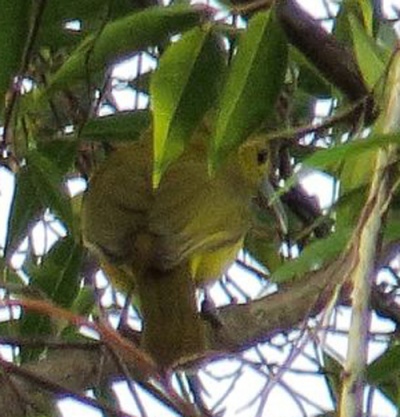(completed) |
KCFoggin-243 (talk | contribs) |
||
| Line 1: | Line 1: | ||
'''Alternative names: Isabella Oriole; Green-lored Oriole; Olive-lored Oriole''' | '''Alternative names: Isabella Oriole; Green-lored Oriole; Olive-lored Oriole''' | ||
;[[:Category:Oriolus|Oriolus]] isabellae | ;[[:Category:Oriolus|Oriolus]] isabellae | ||
| + | [[Image:IsabelaOrioleMH.JPG|thumb|400px|right|Photo © by {{user|Mark+Harper|Mark Harper}}<br />North Luzon, [[Philippines]], March, 2019]] | ||
==Identification== | ==Identification== | ||
21-23 cm. | 21-23 cm. | ||
| Line 32: | Line 33: | ||
==External Links== | ==External Links== | ||
{{GSearch|Oriolus+isabellae}} | {{GSearch|Oriolus+isabellae}} | ||
| − | [[Category:Birds | + | [[Category:Birds]] [[Category:Oriolus]] |
Latest revision as of 22:21, 14 April 2019
Alternative names: Isabella Oriole; Green-lored Oriole; Olive-lored Oriole
- Oriolus isabellae
Identification
21-23 cm.
- Uniformly yellowish-olive upperparts
- Brighter yellow around eye, yellowish-olive lores
- Yellow-olive upperwing, remiges with dull brown inner webs
- Yellowish-olive uppertail, yellower below, narrowly tipped pale yellowish
- Plain yellow chin, throat and underparts
- Grey orbital ring around dark brown to reddish-brown eye
Sexes similar, immatures undescribed.
Distribution
Endemic to the mountains of northern and western Luzon, The Philippines. Occurs in the provinces of Cagayan, Quirino, Isabela and Bataan (probably extinct in Bataan).
A critically endangered restricted-range species. The small population is declining rapidly due to ongoing habitat loss. Survives in northeast Luzon, last record in Bataan province in 1947.
Taxonomy
This is a monotypic species.
May form a superspecies with Dark-throated Oriole and Philippine Oriole.
Habitat
Found in lowland rainforest, especially in thick bamboo forest. Also in secondary growth and at forest edge.
Occurs up to 440 m.
Behaviour
Diet
Feeds on fruits. Takes also insects and their larvae.
Forages singly, in pairs or small groups, often in fruiting trees and in mixed-species flocks.
Breeding
Breeding recorded in April and May. No other information.
Movements
Presumably a sedentary species.
References
- Clements, J. F., T. S. Schulenberg, M. J. Iliff, B.L. Sullivan, C. L. Wood, and D. Roberson. 2013. The eBird/Clements checklist of birds of the world: Version 6.8., with updates to August 2013. Downloaded from http://www.birds.cornell.edu/clementschecklist/download/
- Handbook of the Birds of the World Alive (retrieved July 2014)
Recommended Citation
- BirdForum Opus contributors. (2024) Isabela Oriole. In: BirdForum, the forum for wild birds and birding. Retrieved 24 April 2024 from https://www.birdforum.net/opus/Isabela_Oriole




